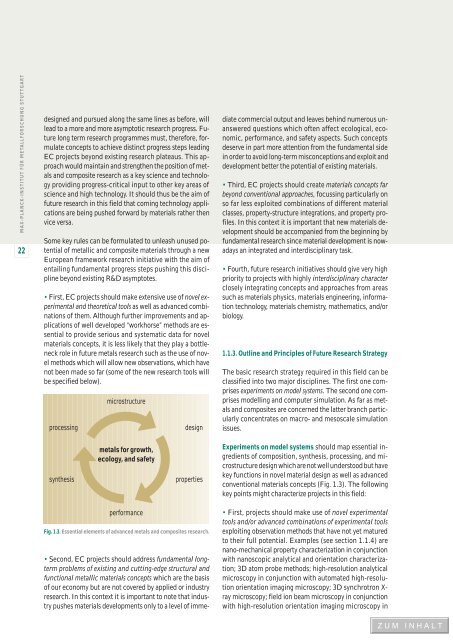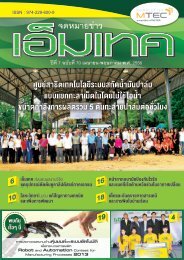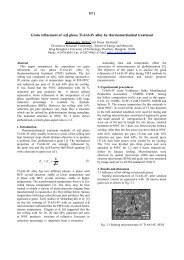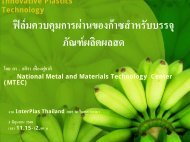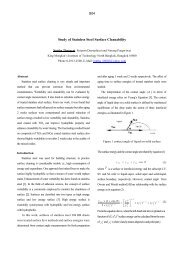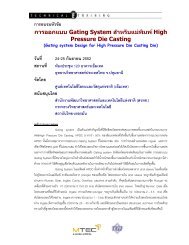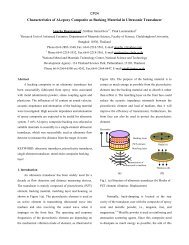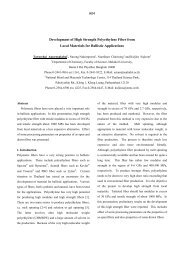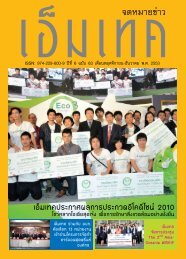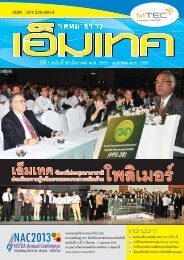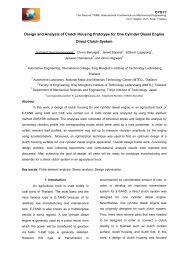EUROPEAN WHITE BOOK
EUROPEAN WHITE BOOK
EUROPEAN WHITE BOOK
You also want an ePaper? Increase the reach of your titles
YUMPU automatically turns print PDFs into web optimized ePapers that Google loves.
MAX-PLANCK-INSTITUT FÜR METALLFORSCHUNG STUTTGART22designed and pursued along the same lines as before, willlead to a more and more asymptotic research progress. Futurelong term research programmes must, therefore, formulateconcepts to achieve distinct progress steps leadingEC projects beyond existing research plateaus. This approachwould maintain and strengthen the position of metalsand composite research as a key science and technologyproviding progress-critical input to other key areas ofscience and high technology. It should thus be the aim offuture research in this field that coming technology applicationsare being pushed forward by materials rather thenvice versa.Some key rules can be formulated to unleash unused potentialof metallic and composite materials through a newEuropean framework research initiative with the aim ofentailing fundamental progress steps pushing this disciplinebeyond existing R&D asymptotes.• First, EC projects should make extensive use of novel experimentaland theoretical tools as well as advanced combinationsof them. Although further improvements and applicationsof well developed “workhorse” methods are essentialto provide serious and systematic data for novelmaterials concepts, it is less likely that they play a bottleneckrole in future metals research such as the use of novelmethods which will allow new observations, which havenot been made so far (some of the new research tools willbe specified below).processingmicrostructuredesign• Second, EC projects should address fundamental longtermproblems of existing and cutting-edge structural andfunctional metallic materials concepts which are the basisof our economy but are not covered by applied or industryresearch. In this context it is important to note that industrypushes materials developments only to a level of immediatecommercial output and leaves behind numerous unansweredquestions which often affect ecological, economic,performance, and safety aspects. Such conceptsdeserve in part more attention from the fundamental sidein order to avoid long-term misconceptions and exploit anddevelopment better the potential of existing materials.• Third, EC projects should create materials concepts farbeyond conventional approaches, focussing particularly onso far less exploited combinations of different materialclasses, property-structure integrations, and property profiles.In this context it is important that new materials developmentshould be accompanied from the beginning byfundamental research since material development is nowadaysan integrated and interdisciplinary task.• Fourth, future research initiatives should give very highpriority to projects with highly interdisciplinary characterclosely integrating concepts and approaches from areassuch as materials physics, materials engineering, informationtechnology, materials chemistry, mathematics, and/orbiology.1.1.3. Outline and Principles of Future Research StrategyThe basic research strategy required in this field can beclassified into two major disciplines. The first one comprisesexperiments on model systems. The second one comprisesmodelling and computer simulation. As far as metalsand composites are concerned the latter branch particularlyconcentrates on macro- and mesoscale simulationissues.synthesismetals for growth,ecology, and safetypropertiesExperiments on model systems should map essential ingredientsof composition, synthesis, processing, and microstructuredesign which are not well understood but havekey functions in novel material design as well as advancedconventional materials concepts (Fig. 1.3). The followingkey points might characterize projects in this field:performanceFig. 1.3. Essential elements of advanced metals and composites research.• First, projects should make use of novel experimentaltools and/or advanced combinations of experimental toolsexploiting observation methods that have not yet maturedto their full potential. Examples (see section 1.1.4) arenano-mechanical property characterization in conjunctionwith nanoscopic analytical and orientation characterization;3D atom probe methods; high-resolution analyticalmicroscopy in conjunction with automated high-resolutionorientation imaging microscopy; 3D synchrotron X-ray microscopy; field ion beam microscopy in conjunctionwith high-resolution orientation imaging microscopy in


